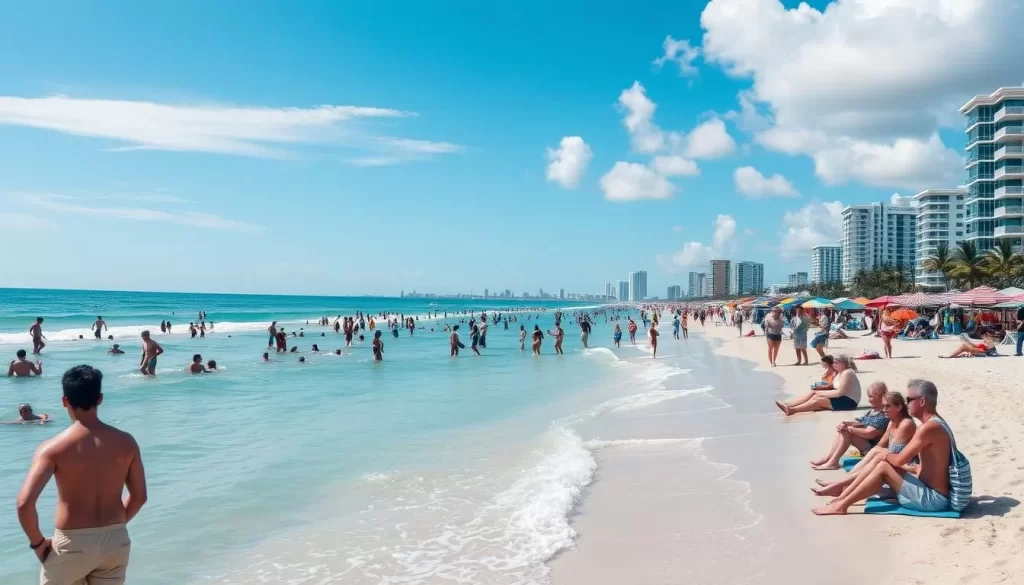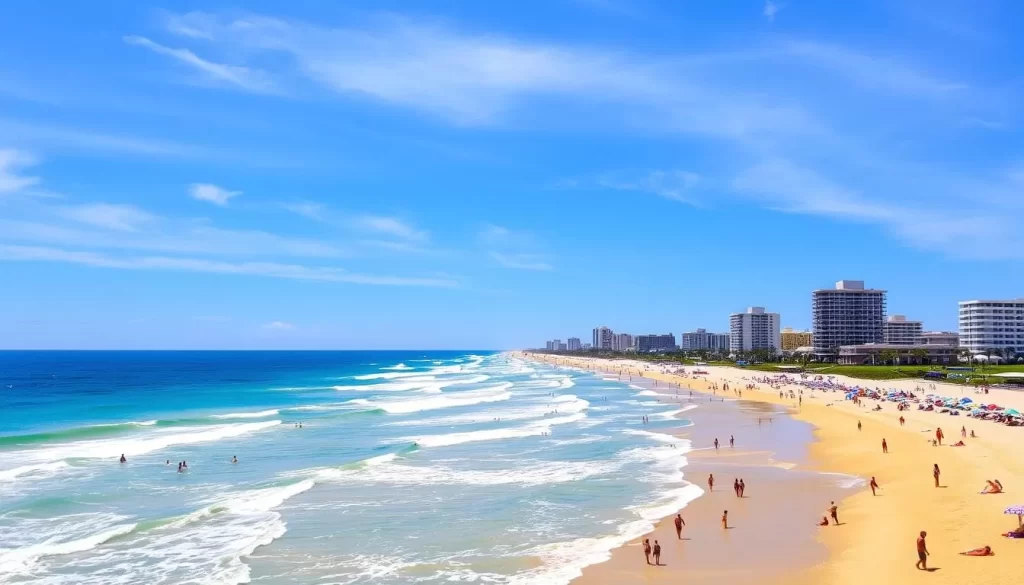✓ Accommodations✓ Flights✓ Rental Cars✓ Tours & Activities
Planning a trip to Florida can be a daunting task, especially when considering the state’s unique weather patterns. The Sunshine State’s climate is characterized by warm summers and mild winters, making it a great destination for travelers seeking to escape harsh weather conditions.
With temperatures ranging between 69°F and 84°F throughout the year, Florida remains a popular destination for tourists. However, the state’s weather varies significantly across different regions, from the theme parks of Orlando to the coastal areas of Miami and Palm Beach.
To make the most of your trip, it’s essential to understand the weather conditions and choose the right months for your visit. This guide will help you determine the ideal time to visit Florida based on your preferences and activities.
Understanding Florida’s Unique Climate
With its subtropical climate, Florida offers a unique experience for travelers, but it requires some knowledge to navigate. The state’s climate is characterized by its humid subtropical classification, which means you can expect hot, humid summers and mild, relatively dry winters.
Florida’s climate is influenced by its geographical location, with the state’s weather patterns shaped by its coastal position and latitude. The majority of the state experiences two primary seasons: a wet season from May to October and a dry season from November to April.
The Sunshine State’s Weather Patterns
The weather in Florida is known for its variability, with temperatures soaring during the summer months. July and August are the hottest months, with temperatures often reaching 92 degrees Fahrenheit. The combination of high temperatures and humidity can make the weather feel particularly oppressive during these months.
Florida receives an average of 53 inches of rainfall annually, with the majority of rain occurring during the wet season. You should be prepared for occasional showers and thunderstorms during this time.
| Season | Characteristics | Time of Year |
|---|---|---|
| Wet Season | Hot, humid, frequent thunderstorms | May to October |
| Dry Season | Mild, relatively dry | November to April |
Regional Climate Variations Across Florida
The climate in Florida varies significantly across different regions. The northern parts of the state experience more seasonal fluctuations in temperatures compared to the consistently warm southern areas. Coastal areas benefit from sea breezes that moderate temperatures, while inland locations like Orlando can feel hotter due to the lack of these cooling effects.
Understanding these regional climate differences is crucial when planning your trip, as weather conditions can vary significantly between the Panhandle, Central Florida, and the Keys at the same time of year.
Florida, United States: Best Months for a Weather-Savvy Trip
Planning a trip to Florida requires more than just picking a destination; it demands timing your visit with the best weather conditions. The state’s diverse climate means that some months are more suitable for certain activities than others.
The best time to visit Florida largely depends on your preferences and the activities you have planned. Generally, the period between January and April is considered ideal due to the pleasant weather, with cool temperatures and low humidity.

Winter Months: December to February
Winter in Florida is characterized by mild temperatures, ranging from 60°F to 75°F, making it an attractive time for tourists seeking to escape colder climates. The low humidity and minimal rainfall during these months create perfect conditions for outdoor activities such as hiking, biking, or visiting theme parks.
During the winter months, you’re likely to enjoy festivals and events that take place across the state, enhancing your Florida experience with cultural activities and celebrations.
Spring Months: March to May
As winter fades, spring brings pleasant temperatures between 70°F and 85°F, with moderate humidity and rainfall. This season is ideal for beach visits and water activities before the summer heat sets in. Spring is also a great time to enjoy the various festivals and outdoor events that Florida is known for.
Whether you’re planning to focus on the northern or southern parts of the state, spring offers a great balance of comfortable weather and exciting activities, making it one of the best months to visit Florida.
When planning your trip, consider that the best time to visit also coincides with higher tourist numbers in certain areas. Balancing your preferences for weather with crowd considerations is key to a successful trip.
Winter in Florida: December to February
If you’re looking to escape the cold, Florida’s winter months provide an ideal getaway. With its subtropical climate, the state offers a warm and welcoming environment during the winter season.
Temperature and Rainfall Expectations
During the winter months, Florida experiences mild temperatures, making it an attractive destination for those seeking warmer climates. Daytime temperatures typically range from 65°F to 75°F, providing perfect conditions for outdoor activities. You can expect minimal rainfall during this period, with clear blue skies being a common feature across the state.
- Northern Florida tends to be cooler than the southern regions, with occasional cold fronts bringing temperatures down into the 40s°F.
- In contrast, areas like Miami and the Keys maintain more consistent warmth, making them ideal for visitors who prefer milder winters.
- The dry conditions during winter make it an excellent time for exploring Florida’s outdoors without the interruption of frequent rain showers.
Winter Activities and Attractions
Florida’s winter season is not just about pleasant weather; it’s also a time for various activities and attractions. You can enjoy outdoor pursuits like hiking, biking, or simply taking a stroll through the state’s many parks and gardens. The season is also ideal for wildlife viewing, with manatees gathering in warm springs and numerous bird species migrating to the state’s diverse ecosystems.
While winter is a popular time to visit Florida, attracting significant crowds to destinations like Orlando and Miami, especially during holiday periods, it’s essential to plan ahead for your accommodations to avoid any inconvenience.
Spring in Florida: March to May
Florida’s spring season is known for its gentle temperatures and vibrant natural beauty. As the weather transitions from winter to summer, the state experiences a pleasant period ideal for outdoor activities.
During the spring months, daytime temperatures gradually warm from the 70s°F in March to the mid-80s°F by May. This creates ideal conditions for outdoor exploration and enjoying the state’s renowned beaches and natural areas.
Weather Conditions During Spring
Spring in Florida brings relatively low rainfall, particularly in March and April, before the wet season begins in late May. This allows for reliable outdoor activity planning.
The pleasant weather makes spring an excellent time to visit Florida’s many botanical gardens and natural areas, as the native plants are in bloom.
| Month | Average High Temperature (°F) | Average Low Temperature (°F) | Average Rainfall (inches) |
|---|---|---|---|
| March | 78 | 62 | 2.5 |
| April | 82 | 66 | 2.8 |
| May | 86 | 70 | 3.5 |
Spring Break Considerations
Spring break periods, typically in March, bring significant crowds to beach destinations and theme parks. If you’re not traveling for spring break, consider planning your visit for April or early May to enjoy excellent weather while avoiding the peak spring break crowds and higher accommodation rates.
By April, water temperatures begin warming to comfortable swimming levels, making late spring an ideal time for beach activities and water sports before the intense summer heat arrives.

Summer in Florida: June to August
Summer in Florida is a season of sweltering heat, vibrant culture, and endless sunshine. As you plan your trip during these months, it’s essential to understand what to expect from the weather and how to make the most of your visit.
Heat, Humidity, and Afternoon Thunderstorms
During the summer months, Florida experiences its highest temperatures, often ranging from 85°F to 95°F, accompanied by high humidity levels that can make the heat feel even more intense. This period is also characterized by frequent afternoon thunderstorms that bring heavy rainfall for short durations, typically 1-2 hours, before clearing up. These storms not only provide relief from the heat but also add to the dramatic tropical atmosphere.
Key Weather Characteristics:
- High temperatures and humidity
- Frequent afternoon thunderstorms
- Heavy but short-duration rainfall
Beach Conditions and Water Activities
Despite the challenging weather conditions, summer offers some of the best beach experiences in Florida. The ocean and gulf waters are at their warmest, often above 85°F, making them perfect for swimming, snorkeling, and other water activities. Early mornings and evenings are the best times for outdoor activities, as the temperatures are more comfortable during these periods.
Moreover, the summer season brings lower accommodation rates and special offers at many resorts and attractions, making it a budget-friendly time to visit Florida if you’re prepared for the heat and humidity. Beach conditions are generally excellent in the mornings, with the Gulf Coast often experiencing calmer waters compared to the Atlantic beaches.
Tips for Enjoying Summer in Florida:
- Plan your outdoor activities around the predictable afternoon rainfall patterns.
- Take advantage of the warm waters for swimming and snorkeling.
- Look out for special offers and discounts at resorts and attractions.
Fall in Florida: September to November
The fall season in Florida is characterized by a gradual transition from the sweltering heat of summer to more moderate temperatures, making it an attractive time for tourists and locals alike to enjoy the outdoors.
As the summer months come to a close, the weather in Florida begins to change, offering a more pleasant climate for various activities. You can expect daytime highs to range from the upper 80s°F in September to the mid-70s°F by November, with a significant drop in humidity levels as the season progresses.
Transitioning Weather Patterns
During the fall, Florida experiences a steady decrease in rainfall as the wet season concludes. October and November offer increasingly dry and pleasant weather conditions, ideal for outdoor activities such as visiting the beaches, hiking, or exploring the state’s natural beauty.
It’s worth noting that September remains part of the hurricane season, with the highest statistical risk, while October sees diminishing storm threats, and November marks the official end of hurricane season. You should be aware of these weather patterns when planning your trip.

Fall Events and Attractions
Fall in Florida brings a variety of seasonal events and attractions, offering unique cultural experiences without the large crowds typically seen during the winter months. You can enjoy Halloween celebrations, food and wine festivals, and art shows throughout the state.
The more relaxed atmosphere at attractions and beaches, combined with the pleasant weather, makes fall an excellent time to visit Florida. Whether you’re looking to unwind or explore new places, the fall season in Florida has something to offer.
Hurricane Season: What Travelers Should Know
When planning a trip to Florida, it’s essential to understand the risks associated with hurricane season. Florida is no stranger to hurricanes, and the official hurricane season runs from June to November. During this time, it’s crucial for residents and visitors to stay informed and prepared for potential tropical storms and hurricanes.
Hurricane Season Timeline and Risks
Hurricane season officially runs from June 1st to November 30th, with peak activity typically occurring between mid-August and late October when ocean temperatures are warmest. The statistical risk of a hurricane affecting your specific Florida vacation is relatively low, but it’s essential to understand the potential impacts on your travel plans during this time.
Coastal areas face greater hurricane risks than inland locations, though major storms can affect the entire state with heavy rainfall and strong winds. Modern weather forecasting typically provides several days’ notice before a hurricane makes landfall, giving you time to adjust plans if necessary.
- Peak hurricane activity occurs between mid-August and late October.
- Coastal areas are more susceptible to hurricane risks.
- Modern weather forecasting provides several days’ notice before a hurricane makes landfall.
Travel Insurance and Contingency Planning
Consider purchasing travel insurance with hurricane coverage if you’re visiting during hurricane season, especially for trips planned during the peak hurricane months of August and September. Many hotels and vacation rentals offer hurricane guarantees or flexible rebooking policies during this time, which can provide peace of mind when planning your trip.
Staying informed about weather conditions by monitoring reliable sources like the National Hurricane Center and downloading weather alert apps before and during your Florida vacation is crucial.
Orlando Weather Guide: Best Months to Visit

Planning a trip to Orlando requires understanding its weather patterns. The city’s climate can significantly impact your vacation experience, especially when visiting its renowned theme parks.
Theme Park Considerations
When planning your visit to Orlando’s theme parks, consider both the weather and crowd levels. The best months to visit are January through April and November through early December, offering pleasant temperatures ranging from 50°F to 85°F with lower humidity and minimal rainfall. January, after the New Year’s celebrations, and September, after Labor Day, are particularly good, providing a great combination of comfortable weather and shorter wait times for attractions.
Orlando’s Unique Weather Patterns
Orlando experiences a unique microclimate due to its inland location, resulting in slightly higher daytime temperatures and cooler nights compared to coastal areas. During the summer months, daily afternoon thunderstorms are common, typically lasting 1-2 hours, which can interrupt theme park activities but often lead to reduced crowds afterward. It’s essential to consider these weather patterns when planning your daily itinerary, scheduling outdoor activities for mornings during summer and midday during winter for optimal comfort.
By understanding Orlando’s weather and its impact on your visit, you can make informed decisions to ensure a enjoyable and stress-free vacation. Whether you’re looking to avoid crowds or make the most of your time at the theme parks, being aware of the best time to visit Orlando can make all the difference.
Miami Weather Guide: Best Months to Visit

The Sunshine State’s gem, Miami, boasts a climate that is as vibrant as its culture, with certain times being better to visit than others. Understanding the weather patterns is crucial for making the most out of your trip.
Beach Season in Miami
Miami’s beach season extends year-round, but the water temperatures are most comfortable from April through November. During the summer months, the ocean conditions are warmest for swimming. If you’re looking for a beach vacation, the best months to enjoy Miami’s beaches are between April and October, when the weather is warm and sunny.
Miami’s Cultural Events Calendar
Miami’s cultural events calendar is packed with exciting activities throughout the year. The best time to visit for culture enthusiasts is during the winter months, with major international events like Art Basel in December and the Miami International Boat Show in February. Additionally, the Calle Ocho Festival in March and the Miami Book Fair in November are other highlights to consider.
When planning your trip, consider the time to visit based on your preferences. If you prefer fewer crowds and lower prices, the shoulder season (May and October-November) might be ideal. The weather during these periods is generally favorable, making it a great time to visit Miami for those looking for a more relaxed experience.
Palm Beach Weather Guide: Best Months to Visit

If you’re planning a trip to Palm Beach, understanding the local weather patterns is crucial for making the most of your visit. Palm Beach, located in Southeast Florida and north of Miami, offers sublime weather for a vacation. The best months to visit are March through May and October through December, when temperatures range from 65°F to 85°F with lower humidity and reduced rainfall.
Outdoor Activities in Palm Beach
Palm Beach’s weather creates ideal conditions for outdoor activities year-round. Golf, tennis, boating, and beach activities are particularly enjoyable during the spring and fall months. The comfortable weather during these periods makes it perfect for engaging in these activities without the harsh conditions of summer or winter.
Palm Beach’s Seasonal Attractions
Palm Beach hosts various seasonal attractions that draw visitors from around the world. The Palm Beach International Boat Show in March, SunFest music festival in May, and the Palm Beach Food & Wine Festival in December are some of the notable events. These events add to the vibrant cultural scene of Palm Beach, making it a great destination for those looking for more than just good weather.
When planning your visit, consider Palm Beach’s seasonal rhythm. The winter high season (January-April) brings more crowds and higher prices but also the most vibrant social scene and cultural events. Understanding the best time to visit for your preferred activities and attractions will help you make the most of your trip.
Florida Keys: Weather Considerations

The Florida Keys boast a unique microclimate, influenced by the surrounding waters, creating a haven for water enthusiasts. This tropical island chain enjoys the most consistent temperatures in the state, with winter lows rarely dropping below 65°F and summer highs typically reaching the upper 80s°F.
Unique Climate Characteristics
The Keys’ tropical climate means that the temperature variation is less pronounced compared to mainland Florida. The surrounding ocean waters play a significant role in moderating the climate, resulting in more consistent sea breezes and a generally pleasant weather condition year-round. You can expect lower humidity and minimal rainfall from November through May, making this period ideal for exploring both land and water attractions.
Ideal Time to Visit: The best time to visit the Florida Keys for ideal weather is from November through May. During this period, you can enjoy outdoor activities without the discomfort of high humidity or the risk of hurricanes, which are more common from June to November.
Seasonal Water Activities
Water activities in the Florida Keys vary seasonally, offering a range of experiences for visitors. The drier winter months provide the best visibility for snorkeling and diving, as less rainfall results in clearer waters. Marine life in the Keys follows seasonal patterns: lobster season runs from August through March, tarpon fishing peaks from May through July, and turtle nesting occurs from April through October.
Whether you’re interested in fishing, snorkeling, or simply enjoying the beach, understanding the seasonal patterns can help you plan your trip to the Florida Keys. The weather creates year-round opportunities for outdoor activities, but the most comfortable time for land exploration is during the winter months when temperatures and humidity are lower.
Avoiding Crowds: Off-Peak Travel Months
Florida’s popularity as a tourist destination means that some months are better than others for avoiding large crowds. Understanding the patterns of tourist traffic can help you plan a more relaxed and enjoyable trip. The key is to find a balance between favorable weather and manageable crowd levels.
Balancing Weather and Crowd Levels
To achieve this balance, consider visiting during the off-season. In Orlando, for instance, the off-season typically falls between February and May. During this time, you can enjoy the city’s attractions and theme parks with more ease and comfort. The number of tourists is generally lower, and hotels tend to have more availability and offer deals. You can also consider visiting in September, October, and early November, when children are back in school and summer vacationers have returned home.
Additionally, January (after New Year’s) through early February offers reduced crowds at major attractions, creating a more relaxed experience with shorter wait time. May is another excellent month, as it falls after spring break but before summer vacation season begins, offering a good balance between weather and crowd levels.
Shoulder Season Advantages
Florida’s shoulder season months, which include April-May and September-October, provide significant advantages. You can enjoy reduced wait times, more availability for dining reservations, and a more authentic experience of local culture without the tourist crush. Weekdays consistently see fewer crowds than weekends throughout the year, with Tuesday through Thursday typically offering the lowest attendance at theme parks and attractions.
It’s also worth noting that different regions of Florida experience varying crowd patterns. Beach destinations see peak crowds during spring break and summer, while Orlando experiences additional crowd surges during school holidays and special events. Planning your visit around these patterns can help you have a more enjoyable trip.
Budget-Friendly Travel: When to Find the Best Deals
You can enjoy a fantastic vacation in Florida without breaking the bank if you know when to go. The key is to understand the seasonal price fluctuations and take advantage of the best deals.
Florida’s tourist industry experiences a significant shift in demand throughout the year, resulting in varying prices for accommodations and vacation packages. Seasonal price fluctuations play a crucial role in determining the cost of your trip.
Seasonal Price Fluctuations
During the off-season months of September through November, hotels and vacation rentals often reduce rates by 20-40% compared to peak season. This period offers an excellent opportunity to save money on accommodations. Additionally, late August through September provides exceptional value with significantly discounted accommodation rates, although travelers should be aware that this coincides with the height of hurricane season.
- January (after New Year’s) through early February: Many properties offer special promotions to fill rooms during this brief lull between holiday and spring break crowds.
- April-May and September-October: Package deals combining accommodations, attractions, and sometimes airfare are most abundant during Florida’s shoulder seasons, offering substantial savings for flexible travelers.
- The first two weeks of December: Enjoy excellent weather and significantly reduced crowds while taking advantage of pre-holiday promotions.
Package Deals and Discounts by Season
To make the most of your vacation, consider package deals and discounts that are available during different seasons. During the shoulder seasons (April-May and September-October), you can find packages that include accommodations, attractions, and sometimes airfare at discounted rates.
While summer months (June-August) offer lower accommodation rates in many areas, these deals come with the trade-off of hot, humid weather and afternoon thunderstorms that may impact your vacation activities.
Packing Guide for Florida’s Changing Seasons
To make the most of your Florida vacation, it’s crucial to pack wisely, taking into account the state’s changing seasons. Florida’s weather can be quite dynamic, with significant variations across different times of the year. Understanding these variations is key to ensuring a comfortable and enjoyable trip.

Essential Items Year-Round
Regardless of when you visit Florida, there are certain essentials that you should always include in your packing list. Sunscreen with a minimum SPF of 30 is a must, given the state’s sunny weather year-round. Sunglasses are another essential item to protect your eyes from the sun’s glare. Additionally, a reusable water bottle will help you stay hydrated throughout your trip. These items are crucial for making your trip comfortable and enjoyable.
You should also consider the activities you plan to engage in during your trip. For instance, if you’re heading to the beach, sandals and water shoes are a must. For theme parks, comfortable walking shoes are essential, while closed-toe hiking shoes are better suited for nature trails.
Seasonal Packing Tips
While certain items are essential year-round, your packing list should also be tailored to the specific season you’re visiting. During the summer months (June-September), it’s advisable to pack lightweight, breathable clothing and moisture-wicking fabrics to keep you cool in the heat. Don’t forget a rain jacket or poncho for unexpected afternoon showers, and insect repellent to keep mosquitoes at bay during the humid evenings.
In contrast, winter (December-February) requires a different approach, with layers being key to managing the fluctuating temperatures, especially in northern Florida. For spring and fall, a versatile wardrobe that includes a mix of shorts, pants, short and long-sleeved shirts, and a light jacket or sweater for cooler evenings is ideal.
By packing wisely according to the season and your planned activities, you can ensure a more enjoyable and stress-free trip to Florida.
Weather-Based Activity Planning
To get the most out of your Florida trip, it’s essential to plan your activities with the weather in mind. The state’s diverse climate means that certain activities are better suited to specific times of the year.
Indoor Activities for Rainy Days
Florida’s rainy season, which typically runs from May to October, can bring afternoon thunderstorms that might interrupt your outdoor plans. However, this doesn’t mean you have to put your activities on hold. Florida’s museums, aquariums, and indoor attractions offer excellent alternatives for rainy days. Major cities like Orlando, Miami, and Tampa feature world-class indoor entertainment options. For instance, you can visit the Kennedy Space Center, explore the many art galleries in Wynwood, or enjoy the interactive exhibits at the Miami Children’s Museum.
Always having a backup plan for indoor activities ensures that your trip remains enjoyable despite the weather. Some of the activities you can consider include visiting indoor shopping malls, enjoying indoor pools with heated water, or taking part in indoor sports like bowling or laser tag.
Outdoor Adventures by Season
The time of year you visit Florida will significantly influence the activities you can enjoy. During the summer months, water-based activities like snorkeling, diving, and visiting waterparks are ideal due to the warm water temperatures and extended daylight hours. In contrast, the winter months (December to February) are perfect for hiking, biking, and wildlife viewing, as the comfortable temperatures and minimal rainfall create ideal conditions for outdoor exploration.
The spring and fall months offer the most flexibility for all types of activities, with pleasant temperatures and reduced rainfall making it possible to enjoy both indoor and outdoor adventures throughout the day. By considering the weather patterns and planning your activities accordingly, you can make the most of your visit to Florida.
Conclusion
Whether you’re looking for sun, fun, or outdoor adventures, Florida’s climate plays a significant role in shaping your experience. The best time to visit Florida ultimately depends on your personal preferences, whether you’re seeking perfect beach weather, minimal crowds, budget-friendly options, or specific seasonal activities.
For most travelers, the best months to visit Florida are March through May and October through November. During these periods, you’ll experience pleasant temperatures, lower humidity, and reduced rainfall while avoiding peak tourist crowds. If you’re looking for a weather-savvy trip, these periods offer an ideal climate.
Other considerations include winter months (December-February), which offer excellent weather conditions but come with higher prices and larger crowds. Summer travel (June-September) provides budget advantages and warm water temperatures ideal for beach activities, though you’ll need to plan around afternoon thunderstorms and higher humidity levels.
By understanding Florida’s weather patterns and following this guide, you can confidently choose the best time to visit Florida that aligns with your preferences, budget, and desired activities. Whether you’re planning a family vacation, a romantic getaway, or an outdoor adventure, Florida offers year-round possibilities with each season providing its own unique advantages and memorable experiences.
The above is subject to change.
Check back often to TRAVEL.COM for the latest travel tips and deals.






